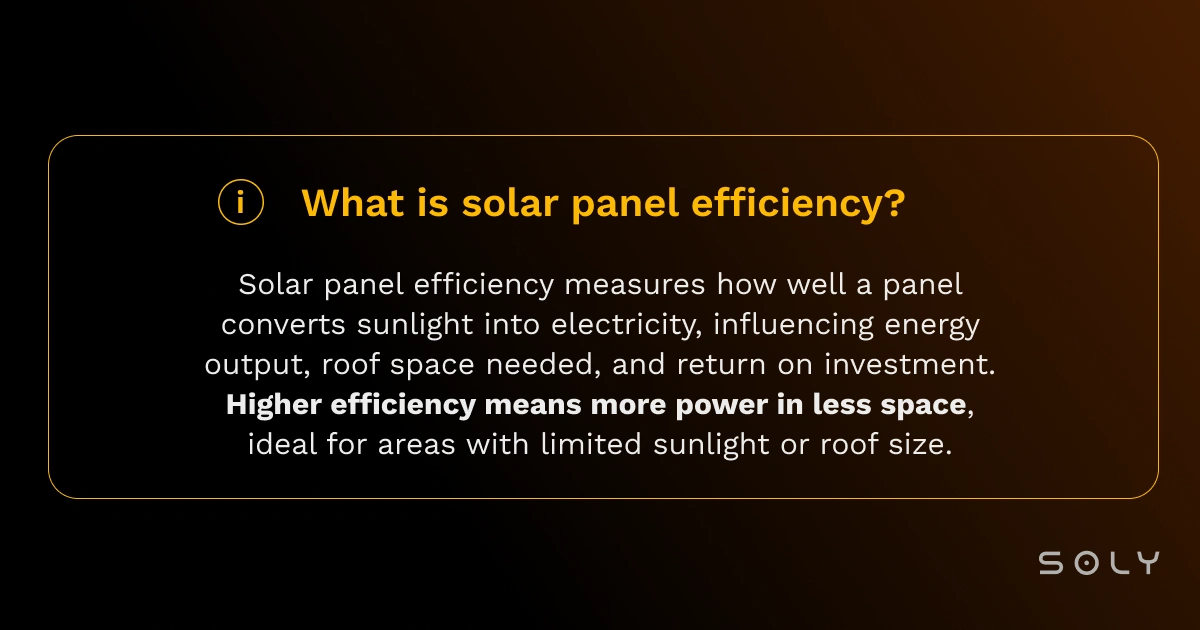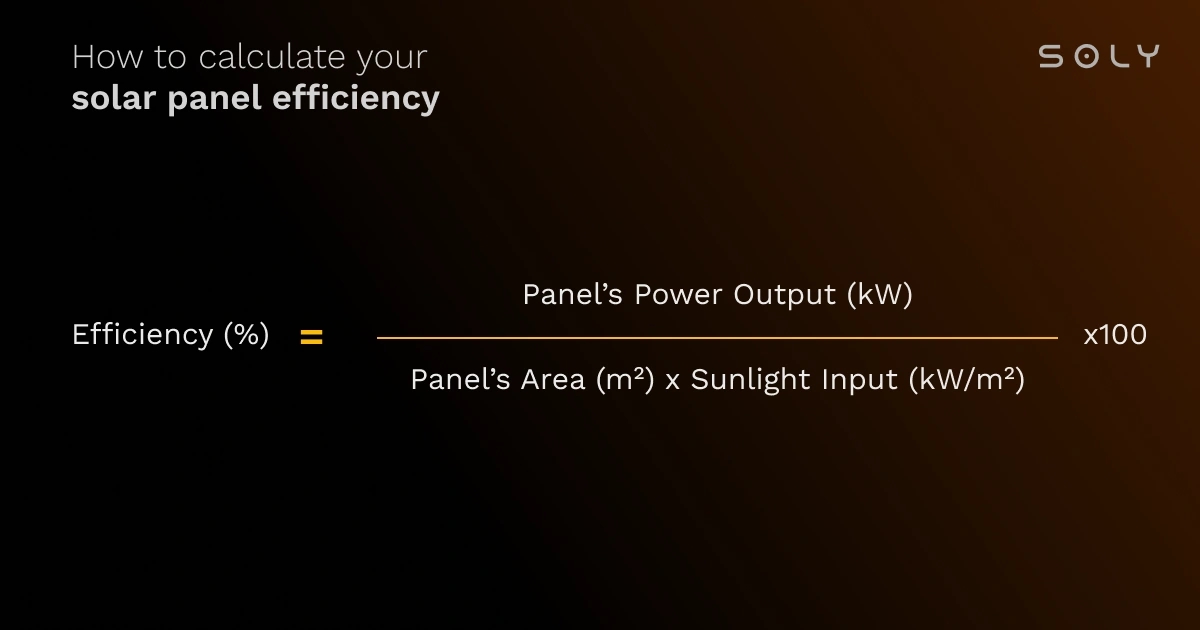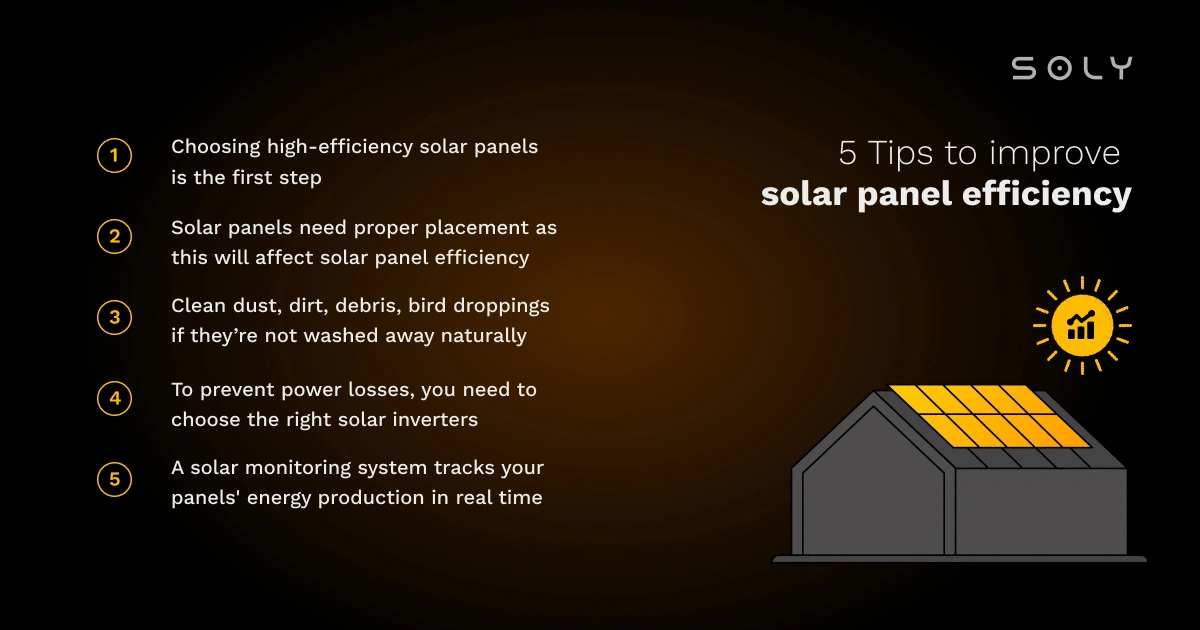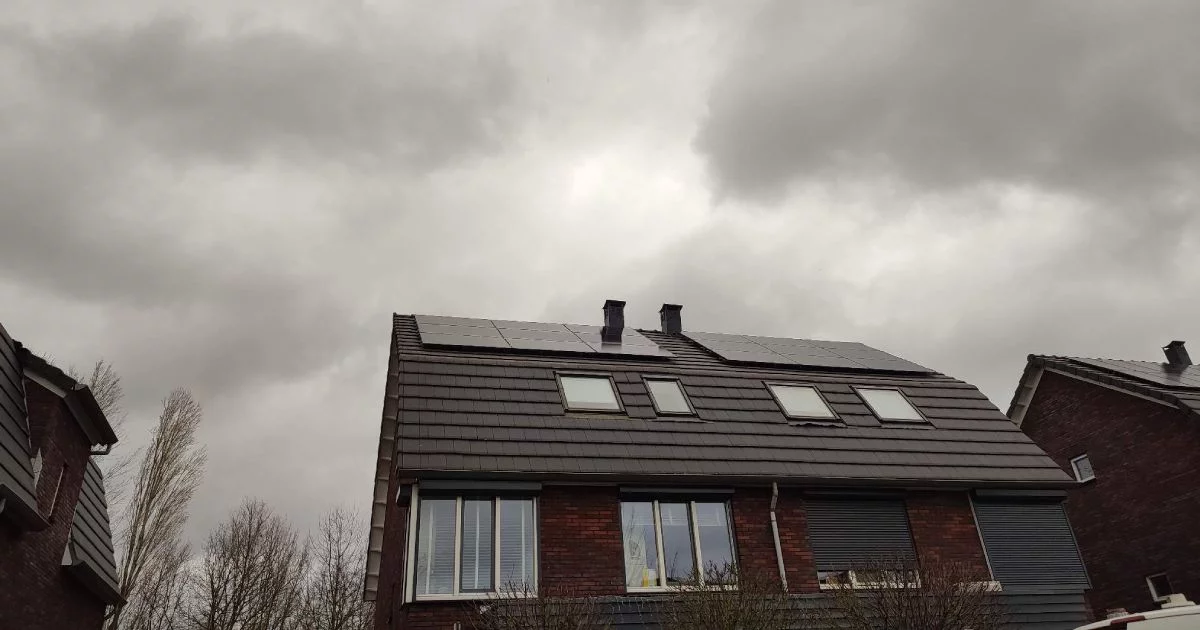Solar panel efficiency: Everything you need to know
Are solar panels built to handle your energy needs? With the recent advances in technology, the answer to that is a resounding yes. In fact, solar panels are becoming much more efficient at converting sunshine into electricity. But what does solar panel efficiency really mean for homeowners and how does it affect your overall energy savings?
To put it simply, solar cell efficiency refers to how much sunlight a panel can convert into usable energy. So, the higher the efficiency, the more electricity your system can produce, even with limited roof space or during the cloudiest of days. Understanding how solar panel efficiency works can help you choose the best solar PV system for this endeavour in your home. This way you can maximise your return on investment.
On this page, you’ll learn:
- What solar panel efficiency means and how it’s measured.
- The different types of solar panels and their efficiency levels.
- Key factors that can affect efficiency over time.
- Tips for choosing the most efficient solar panels to save the most on your energy bills.
Let’s get started!
- What is solar panel efficiency and why does it matter?
- Solar panel efficiency formula: How to calculate solar panel efficiency
- Solar panel types & Efficiency
- Solar panel efficiency over time: 5 key factors affecting solar panel performance
- Improving solar panel efficiency: Top Tips for getting the most out of your solar energy system at home
- FAQs
- The bottom line
What is solar panel efficiency and why does it matter?
Solar panel efficiency is the measure of how effectively a panel can convert sunshine into free electricity. Efficient panels not only produce more energy but also require less space and generate more energy over their lifespan.

For example, high-efficiency panels, like monocrystalline panels, can help you produce enough energy to meet your needs.
But why does this matter?
A more efficient panel means that you’ll get more electricity from the same amount of sunshine. In short, solar panel efficiency is important because it determines how much energy your system produces and how quickly you can recover your investment. This is especially important for homes that don’t have that much roof space or those in locations that don’t get as much direct sunlight.
Faster payback and longer life
Higher-efficiency panels generate more electricity per square metre. This is going to lead to a faster solar panel payback period because you save more on your energy bills.
Additionally, efficient panels tend to have a longer lifespan. This means they will provide clean energy for years. Thus, solar energy can maximise your return on investment and minimise replacement costs over time.
Cost considerations
Although high-efficiency panels may come with a higher initial price, they offer long-term savings. This is because of the increased energy they produce.
Over the years, the cost of solar panels has dropped a great deal.
A decade ago, the average payback period for a solar PV system was around 14-25 years. Now, in 2024, we see that these has been reduced to around 7-8 years! This makes it more affordable to invest in better-performing systems. When looking at the cost, it’s important to think about the total cost of ownership, including installation, maintenance, and the savings on energy bills.
Solar panel efficiency formula: How to calculate solar panel efficiency
Solar panel efficiency measures just how effective a panel is at converting sunshine. It’s calculated by dividing the panel’s power rating (in kilowatts) by the total panel area (length x width in square metres) and multiplying by 100 to get a percentage at Standard Test Conditions (STC).

Here’s a step-by-step how to calculate solar panel efficiency:
- First, you’ll determine the panel’s power: This is usually listed in watts (e.g. 350W or 0.35 kW).
- Then, you’ll calculate the panel’s area: Multiply the length and the width in metres (e.g., 1.64m x 0.99m = 1.6236m²).
- Use standard sunlight input: This is where panels are tested with 1000 W/m² (1 kW/m²) of sunlight.
- Finally, you’ll apply the formula: Efficiency (%) = (0.35 kW ÷ 1.6236m²) x 100 = 21.56%.
This means the panel operates at 21.56% efficiency. This is typical since most residential solar panels range between 15% – 24% efficiency, depending on the materials used. Theoretically speaking, the Shockley-Queisser limit sets the maximum for silicon panels is around 33.7%. However, real-world manufacturing constraints keep most commercial panels below this threshold.
Solar panel types & Efficiency
Choosing just the right solar panel system for your home is going to be based on several factors. These include efficiency, lifespan, cost, and your own needs. Out of all the options, monocrystalline solar panels are the most efficient and they are perfect for homes that don’t have that much roof space.
Polycrystalline solar panels, on the other hand, offer a balance between cost and being efficient. When it comes to panel efficiency, thin film panels are the least efficient. However, they are lightweight and flexible. This makes them much more suited for more specialised applications.
Comparison chart of the most efficient solar panel types
Monocrystalline solar panel efficiency
Of course we know that monocrystalline solar panels are notorious for being the most efficient solar panel available. They are made from a single crystal of silicon and these solar panels can reach cell efficiency rates above 20%.
Because they are the most efficient solar panels, it allows them to produce more power in a smaller space compared to other panels. Though they tend to be more expensive, their durability and performance make them a choice for homeowners who don’t have as much roof space. For example, Jinko Solar’s monocrystalline panels, known for high efficiency, are a leading option in the market.
Polycrystalline solar panel efficiency
Polycrystalline solar panels are made from multiple silicon crystals and have slightly lower efficiency rates compared to monocrystalline panels. Poly solar panel efficiency is typically between 14% and 16%.
That said, polycrystalline solar panels are more affordable, which makes them a popular choice in homes where cost is a concern. Polycrystalline panels do offer a solid balance between performance and price, giving homeowners a great option to look into when they have more roof space but also need to lessen the upfront costs for their solar power residential installations.
Thin-film solar panel efficiency
Thin film solar panels are made by layering thin sheets of photovoltaic material. This is what gives them that flexibility that the other crystalline panels just don’t have.
Although their efficiency ranges from 7% – 15% on average, they are lightweight and pretty versatile. This makes them a good option for specialised applications such as building-integrated photovoltaics. While less efficient, thin-film solar panels are cost-effective and ideal for projects that require flexible installation or have specific design requirements, like curved surfaces.
Keep on reading: All Types of Solar Panels Explained
Solar panel efficiency over time: 5 key factors affecting solar panel performance
Over time, solar panel efficiency gradually declines. This is known as the degradation rate. It shows us just how much electricity a panel produces compared to when it was brand new. But just what causes this drop in the performance? Here are the key factors to take note of:
Of course, we can’t talk about the gradual reduction in a panel’s ability to generate electricity without mentioning the most important factor that comes into play: solar panel degradation. The average degradation rate is between 0.5% and 1% per year.
However, newer models like monocrystalline solar panels tend to degrade more slowly. In fact, some have rates as low as 0.3% annually. This means that after 25 years, most panels still generate 80-90% of their original power.
Additionally, other factors contribute to degradations. These include UV radiation, temperature changes, moisture, and physical impacts like hail or debris. Over time, these elements weaken the materials. This reduces the solar panels’ overall efficiency. It’s important to keep in mind though, that with proper installation and maintenance, you can extend their lifespan.
Solar panel design & materials
In terms of total panel efficiency, the design and materials also impact it overall. The way solar cells are arranged within the panel can influence how well they capture sunshine. Additionally, the solar panel’s protective backsheet colour is going to affect just how much heat is absorbed. Darker colours are going to inevitably absorb more heat.
Moreover, a well-designed solar panel will incorporate features such as better airflow and heat dissipation. These features work to prevent overheating and help to maintain cell efficiency in all weather conditions.
Solar panel orientation
The orientation of your solar panels also plays its own important role in how efficient your solar panel system is. South facing roofs are the most ideal in the UK because they receive the most sunshine throughout the day. But don’t discount north, east, or west facing roofs in that line up. With the right equipment, such as proper solar panel mounting systems and a professional residential installer, such systems can provide an efficient panel system to generate electricity as well.
Additionally, the tilt angle is important. For many homes, an angle between 30-40 degrees is perfect for capturing the sun’s rays. It’s worth noting that if your panels are angled or oriented incorrectly, it can reduce the amount of light they capture, which will lead to lower efficiency.
This makes it pivotal to properly position the solar panels so that they generate electricity to the fullest amount possible throughout the year.
Roof considerations
When it comes to solar cell efficiency, you must also take your roof into consideration. In fact, your roof’s orientation, pitch, size, and condition all play a part here. As mentioned above, a south facing roof is the most ideal for capturing sunlight.
However, with some adjustments, east and west facing roofs can still perform well. The optimal roof pitch that we’ve mentioned above is between 30-40 degrees. But we do want to add that flat roofs can be modified with tilt brackets for a better performance.
Roof size is also important. Typically, a 4kW solar panel system is going to need 20-30m² of space. Moreover, the roof material matters too. Ideal materials are asphalt and metal, while others may need extra preparation to support the panels safely. Finally, your roof has to be structurally sound in order to hold the weight of the solar panels securely.
Weather conditions
Weather conditions have a noticeable impact on total solar panel efficiency. High temperatures can reduce efficiency. Inevitably, this is because solar panels tend to work their best in cooler environments. In fact, low temperatures can actually improve performance. Humidity and moisture can also gradually affect the durability of the panels.
One of the biggest factors is shading. When it comes to converting sunlight, even partial shading from trees or nearby structures can significantly reduce the energy output of solar panels. To keep efficiency at its best, it’s important to look at your local weather patterns and make sure your panels are positioned properly to avoid shading.
Improving solar panel efficiency: Top Tips for getting the most out of your solar energy system at home
Boosting solar cell efficiency is one way to maximise energy production and honing in on long-term savings. Here are our top tips to help you get the most out of your solar panels, including a bonus tip for even more energy optimising power:

Tip 1: Choosing high-efficiency solar panels is the first step
First, you need to choose between Mono vs Poly panels. If you select monocrystalline solar panels, you’re in it to win it, when it comes to maximising efficiency. Since monocrystalline panels are made from a single silicon crystal, they offer better performance, compared to polycrystalline panels. They’re especially beneficial for homes with limited roof space, as they produce more power per square metre.
Though they have a higher upfront cost, the long-term savings in energy production make them a smart investment.
Soly offers only monocrystalline panels to provide the best efficiency and long-term reliability. Of course, you could always choose polycrystalline panels for affordability, but if you want the most efficient solar panels, then mono panels are the way to go.
Tip 2: Solar panel placement is critical
Next up, the solar panels need proper placement as this will affect solar panel efficiency. In an ideal setting, remember: south-facing roofs with an optimal tilt of 30-40 degrees will allow for more direct sunlight all day long.
Additionally keep in mind that shading from nearby trees and structures can reduce output power. We suggest talking to a professional and trusted installer, like those from Soly, to make sure that your panels are right where they need to be for better power rating and panel efficiency.
Tip 3: Regular maintenance and cleaning (when needed)
By design, solar panels are made for minimal upkeep. Cleaning is on an as-needed basis. This ensures that they work at peak efficiency. Of course, over time, dust, dirt, debris, bird droppings, and the like can block the sun’s rays, which will reduce efficiency.
In order to avoid damaging the panels, it’s highly advised to get them cleaned by a professional when needed. Importantly though, when it comes to Soly panels, they don’t require cleaning! Additionally, routine maintenance checks can help identify potential issues early.
Keep on reading: Solar panel maintenance: How often to clean?
Tip 4: Choose the right solar inverters
In order to prevent power losses, you need to choose the right solar inverters. Microinverters or power optimisers can maximise the efficiency of each individual solar panel. This is especially the case if your roof has shading issues.
String inverters are more common but may not optimise energy production as effectively as microinverters. The best way to decide on the correct inverter type is to talk to a solar expert about your specific solar panel setup.
Tip 5: Invest in monitoring systems
A solar monitoring system helps track your panels’ energy production in real-time. These incredible systems alert you to any performance issues. For help with your solar PV system, this enables quick repairs and maintenance to keep your system working efficiently.
Monitoring systems also help you optimise energy production. Additionally, these monitoring systems aim to extend the life of your solar panels by detecting underperformance early on. With Soly, monitoring can be done directly through the app!
Bonus Tip: Consider installing a solar tracker
A solar tracker automatically adjusts the tilt and orientation of your panels to follow the sun throughout the day. When looking at ways to improve your solar panel system, these trackers aim to help maximise sunlight absorption.
Even though trackers can be expensive, they are highly effective at what they do. They are known for increasing energy output, even in areas with frequent cloud cover or spotty sunlight coverage. This added efficiency can provide significant long-term savings that are worth noting.
FAQ
Will solar panels ever reach 50% efficiency?
It’s possible that solar panels will reach 50% efficiency, but only with emerging technologies. Currently, the most efficient commercial panels are around 22-24%, and laboratory tests with tandem perovskite-silicon cells have reached over 30% efficiency.
However, achieving 50% efficiency would likely require advanced technologies like multi-junction cells, which are still in development and primarily used in specialised applications such as space.
What is a good solar panel efficiency?
A good efficiency rate for residential solar panels in the UK is around 18% to 24%, with monocrystalline panels being the most efficient option for homeowners. Panels in this range provide excellent energy output relative to space, which is why they’re commonly used for residential installations.
Why are solar panels only 20% efficient?
Solar panels are only around 20% efficient because of the inherent limitations of silicon-based technology. Factors like heat loss, reflection, and the inability to capture all wavelengths of sunlight reduce the conversion of sunlight into electricity. Advances in materials like perovskite are helping to improve these numbers, but practical limits still exist due to the nature of the materials and the environment.
Is a 90% efficient solar panel possible?
At this stage, a 90% efficient solar panel is not possible due to fundamental physical limits. The Shockley-Queisser limit sets the maximum efficiency of a single-junction silicon solar cell at around 33.7%. While multi-junction cells and concentrator technologies can increase efficiency, 90% remains far beyond current capabilities.

The bottom line
When it comes to boosting your solar panel efficiency and getting the most from your solar energy system, you need to keep a few things in mind. By choosing high-efficiency panels, ensuring optimal placement, and maintaining your system, you can generate more energy and save significantly over the system’s lifespan.
When we understand that factors like solar panel degradation, design, and weather conditions all affect solar panel efficiency, it helps us to make informed decisions about solar panel system installations.
Undoubtedly, solar technology continues to thrive and evolve with performance advancing alongside that. This promises even greater efficiency and performance in the years to come. In our eyes, with these improvements, solar energy remains one of the best long-term investments for reducing energy costs and minimising environmental impact.
Why choose Soly for your solar panel needs?
At Soly, we make solar energy accessible and ensure your photovoltaic system lasts as long as possible, performing at its best. Here’s why we’re the ideal choice for your solar energy journey:
Why choose Soly for your solar panel needs?
At Soly, we make solar energy accessible and ensure your photovoltaic system lasts as long as possible, performing at its best. Here’s why we’re the ideal choice for your solar energy journey:
- Affordable financing: We understand that upfront costs can be a barrier to going solar. That’s why we’ve partnered with Hometree Finance to make it easier for you to switch to clean, renewable power and start saving on your energy bills.
- Referral benefits: Soly offers the best referral scheme in the solar market. As a Soly customer, you can earn £300 for each friend you refer who installs a system with Soly—with no limits! This can significantly help reduce your payback period. For example, one of our customers, Martyn, managed to reduce his payback period by nearly a year by referring just three friends.
- High-quality panels: We use only the best solar panels, offering monocrystalline solar panels from Jinko Solar. Known for their efficiency and durability, these monocrystalline solar panels can last for up to 40 years, ensuring you get the most out of your investment.
- Trusted reputation: Soly is proud to be highly rated on platforms like TrustPilot and Google and recognized as a certified Which? Trusted Trader. We’ve built a reputation for excellence, earning the trust of countless satisfied customers, with our commitment to quality evident in every installation.
- Accredited installers: We work exclusively with local installers nationwide who are accredited by HIES, TrustMark, and MCS, ensuring that your solar system is installed with the highest industry standards in mind. Proper installation plays a huge role in maximising the lifespan of your solar panels.
- Expertise you can trust: With over 10 years of experience in the solar industry, we know how to deliver the best solar solutions tailored to your needs. Our team of experts will ensure your system is designed to last.
- Peace of mind: We provide up to 25-year guarantees for our solar panels and 15-year guarantees for our solar batteries. This means you can have peace of mind knowing your investment is protected for decades to come.
Reach out to our solar experts today to discover how Soly can help you transition to clean, renewable energy with the best products and financing options.